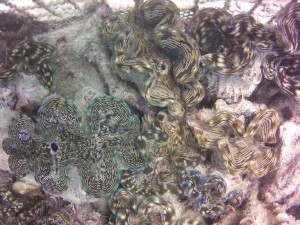Corals reefs is not only about corals. It is a complete eco system. All fish and other marine life has a roll to keep the eco system alive. On Koh Tao there is also the home of a farm project for: Giant Clams. We dove together with the Reef Conservation Program to do some maintenance on the nursery and to monitor the status of the clams. The Giant Clam can grow up to 5 feet in diameter and weigh over 400 lbs! But besides its maximum size, it shows more similarities to corals. Did you know that like corals, their soft tissues contain microscopically small “algae” (dinoflagellates) that collect sunlight and CO2 during the day and turn it into food and oxygen for the clam? Because of its size, its shells were sometimes used instead of a baptismal font to baptise children. In Dutch, its name is even “doopvontschelp” which translates to “font clam”!

Giant Clams have the nicest colors.
Giant Clams are considered “threatened” by the IUCN. Among nature enthusiasts there is a lot of concern about the consequences of overfishing this species. It is considered a delicasy in some parts of the world, and a beautiful pet in others. On the black markets its shells are sold as a trophy. Because of its “popularity” its numbers have dwindled significantly.
All this is happening while the species is of such great importance to a healthy reef. Giant Clams can filter thousands of gallons of sea water each day, and filtered sea water is exactly the stuff that corals and fish need to survive

Frank counts the Giant Clams in a cage.
The Giant Clam reproduces through sperm and eggs. They are collected and combined in a protected environment. This leads to baby clams (spat) which is introduced to the nurseries, open sea cages. Sadly those cages are necessary not only because of predatory fish, but also because of predatory humans. It has happened before that a nursery cage was “harvested” by humans… The Clams are checked regularly and their growth is monitored. When they are large enough, they are moved back to the reef. In 2008 we have worked on such a transportation, a short article of which got published in a Dutch magazine. Nice detail: the Queen of Thailand is the patroness of the Giant Clam!
You can also find this article on my website.
Website: coralgardening.org
Steemit: steemit.com/@coralgardening
Facebook: facebook.com/coralgardening
YouTube: youtube.com/coralgardening
Twitter: twitter.com/Coral_Gardening